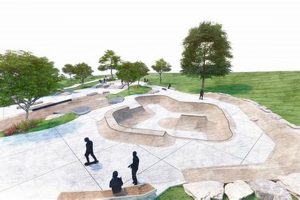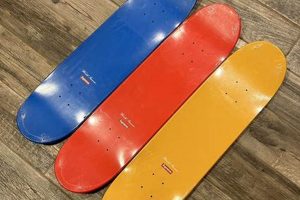The sartorial choices of skateboarders in the initial years of the 21st century constituted a distinct style, characterized by loose-fitting apparel designed for comfort and functionality during physical activity. Distinguishing features included oversized t-shirts, baggy pants, and durable footwear designed to withstand the rigors of skateboarding.
This particular aesthetic held significance as a form of self-expression and cultural identity within the skateboarding community. It offered practical advantages for skaters, allowing for freedom of movement and protection against abrasions. This style reflected a broader cultural shift toward relaxed silhouettes and a rejection of mainstream fashion trends, further solidifying its place as an identifiable subculture.
This article will delve into specific garments, brands, and cultural influences that defined the skater look of that era, providing a detailed overview of its key elements and enduring legacy. Subsequent sections will explore the impact of music, media, and technological advancements on the evolution of this style.
Re-adopting the distinct aesthetic requires attention to detail and an understanding of core elements. The following guidelines offer practical advice for accurately capturing the essence.
Tip 1: Embrace Baggy Silhouettes: Opt for loose-fitting t-shirts, hoodies, and pants. The key is to prioritize comfort and freedom of movement, mirroring the functional requirements of skateboarding.
Tip 2: Prioritize Durable Footwear: Select skate shoes from brands known for their construction and resilience. Look for reinforced stitching, padded collars, and vulcanized soles for optimal performance and longevity.
Tip 3: Incorporate Graphic Elements: Graphic tees featuring bold logos, band imagery, or abstract designs were prevalent. Vintage-inspired graphics can effectively capture the era’s spirit.
Tip 4: Accessorize Appropriately: Beanies, trucker hats, and wristbands were common accessories. Consider these additions to complete the ensemble and enhance authenticity.
Tip 5: Emphasize Layering: Layering was crucial for both practicality and style. Combining t-shirts, hoodies, and jackets allows for adaptability to varying temperatures while adding visual depth.
Tip 6: Understand Brand Heritage: Familiarize oneself with brands that were influential during the early 2000s. Researching their product lines and design aesthetics provides valuable context.
Tip 7: Seek Inspiration from Visual Media: Review skateboarding videos, magazines, and films from the period. These resources offer direct insight into the prevailing trends and stylistic nuances.
Adhering to these guidelines will facilitate the creation of an authentic representation. Prioritizing comfort, durability, and key design elements is essential for successfully adopting the style.
The subsequent sections will examine specific brands, influential figures, and the broader cultural context. This analysis aims to provide a comprehensive understanding and further refine the approach to achieving the desired appearance.
1. Oversized silhouettes
Oversized silhouettes were a defining characteristic within the sartorial landscape of skateboarding during the early 2000s. This preference for voluminous clothing stemmed from a combination of practical requirements and aesthetic choices. The loose fit of garments such as t-shirts, hoodies, and pants allowed for unrestricted movement, a crucial factor for executing skateboarding maneuvers. Furthermore, the adoption of larger sizes provided a degree of protection against abrasions and impacts sustained during falls. The trend extended beyond functionality, reflecting a rejection of the slim-fitting styles prevalent in mainstream fashion at the time, thereby solidifying skateboarding’s distinct identity.
The prevalence of oversized silhouettes can be observed through examining popular skateboarding videos and magazines from the era. Professional skaters often sported extra-large t-shirts paired with baggy cargo pants or wide-leg jeans. Brands like Zoo York, Blind, and Element regularly featured skaters in their advertisements wearing clothing that emphasized this aesthetic. This deliberate choice reinforced the association between skateboarding and a relaxed, anti-establishment attitude. The style also provided a canvas for showcasing graphic designs and brand logos, contributing to the overall visual impact.
Understanding the significance of oversized silhouettes within the context of skateboarding provides insights into the subculture’s values and stylistic evolution. The emphasis on comfort and freedom of movement, combined with a rejection of mainstream fashion norms, shaped a distinctive visual identity. Recognizing this connection allows for a more accurate interpretation of the era’s clothing trends and their underlying cultural significance. The legacy of oversized silhouettes continues to influence contemporary skateboarding fashion, albeit with subtle variations and reinterpretations.
2. Durable skate shoes
Durable skate shoes constituted an indispensable element of the early 2000’s skater aesthetic. The inherent demands of skateboarding, involving frequent contact with abrasive surfaces and high-impact landings, necessitated footwear engineered for resilience. Brands like Vans, DC Shoes, Etnies, and Emerica rose to prominence by designing shoes specifically for this purpose. These shoes typically incorporated reinforced stitching, multiple layers of durable materials such as suede or leather, and vulcanized rubber soles to withstand the extreme wear and tear associated with the sport. The prevalence of such footwear directly influenced the overall look, establishing a practical yet distinctive style within the skateboarding community.
The design features of these durable shoes not only addressed functional requirements but also contributed to the overall visual identity. Padded collars and tongues offered enhanced protection and comfort, while the sturdy construction provided support and stability. The branding of these shoes, often featuring prominent logos and signature designs, further solidified their association with the skateboarding subculture. For example, the Vans Era, with its durable canvas upper and waffle sole, became a ubiquitous symbol of skate style. Similarly, DC Shoes gained recognition for their impact-resistant designs and collaborations with professional skaters. The popularity of these brands cemented the link between performance-oriented footwear and the broader trends.
The understanding of this connection is crucial for appreciating the early 2000’s skateboarding fashion. The selection of footwear was not merely a matter of aesthetic preference but a practical necessity dictated by the demands of the activity. The durability and performance features of these shoes directly influenced their design and ultimately contributed to the distinctive look that characterized the era. Recognizing this interrelationship allows for a more nuanced interpretation of skateboarding fashion as a fusion of functionality and self-expression.
3. Graphic-heavy apparel
Graphic-heavy apparel was an integral component of the early 2000’s skater aesthetic, serving as a potent form of self-expression and brand affiliation within the subculture. The prevalence of boldly designed t-shirts, hoodies, and other garments directly reflected the skater’s identity and allegiances. These graphics often featured brand logos, band imagery, controversial slogans, or abstract designs, acting as visual declarations of personal taste and group membership. The adoption of graphic-heavy apparel was not merely a fashion choice, but a deliberate statement of belonging and individuality. The designs served as conversation starters, providing a visual language through which skaters could connect and identify with one another. Brands like Element, Volcom, and Zero became synonymous with particular graphic styles, fostering a sense of community among those who wore their apparel.
The practical significance of understanding the connection between graphic-heavy apparel and early 2000’s skate style lies in its ability to decode the underlying cultural codes of the era. Analyzing the types of graphics prevalent at the time reveals valuable insights into the values and interests of the skateboarding community. For example, the frequent appearance of punk rock band logos signified a shared rebellious attitude, while skate company graphics demonstrated support for specific brands and their associated ideologies. The scale and placement of these graphics also contributed to the overall aesthetic, with oversized prints and strategic positioning further emphasizing the wearer’s commitment to the style. The knowledge of these design choices allows for a more accurate and nuanced interpretation of skateboarding fashion.
In summary, graphic-heavy apparel played a crucial role in shaping the identity of early 2000’s skateboarding fashion. Serving as a visual representation of personal taste, brand loyalty, and cultural affiliation, these graphics were far more than mere decoration. Recognizing the underlying significance of these design choices provides a deeper understanding of the skateboarding subculture and its sartorial expressions. The legacy of graphic-heavy apparel continues to influence contemporary skateboarding fashion, solidifying its place as a cornerstone of the style. The challenge lies in interpreting the evolving visual language and understanding how it reflects ongoing shifts within the subculture.
4. Functional accessories
The incorporation of functional accessories significantly characterized the aesthetic. Accessories were selected for their utility in the skateboarding environment, but simultaneously became integral stylistic components. Examples include beanies, worn to manage hair and provide warmth, wristbands, used to absorb sweat and prevent injuries, and chain wallets, designed to secure belongings during physical activity. The prevalence of these items underscores a practical approach to dress, where form follows function, yet the adoption of these accessories contributed directly to the distinctive visual language of this era.
Chain wallets, for instance, addressed the need to safeguard currency and identification while skateboarding. The chain connected the wallet to the wearer’s belt loop, preventing loss during tricks and maneuvers. Beanies, often branded with skate company logos, served both a practical purpose and a means of expressing brand allegiance. Wristbands, beyond their absorbent properties, could be adorned with logos or designs, further personalizing the overall look. The selection of these accessories was, therefore, a deliberate act that reinforced both practicality and individual style. This intermingling of function and aesthetics is a hallmark.
In summary, functional accessories were not merely ancillary additions but rather intrinsic elements that shaped the definitive style. The choices made regarding these items reflected a considered approach to dress, prioritizing utility and self-expression in equal measure. Understanding this nuanced relationship is essential for fully appreciating the skateboarding aesthetic and its lasting influence on subsequent fashion trends. The challenge lies in recognizing how seemingly pragmatic choices can coalesce to form a cohesive and culturally significant visual statement.
5. Brand allegiance
Brand allegiance played a pivotal role in shaping the visual identity of early 2000’s skate fashion. The skateboarding subculture fostered strong ties between consumers and specific brands, influencing purchasing decisions and dictating stylistic choices. These brands, such as Vans, Etnies, DC Shoes, Element, and Volcom, were not merely providers of apparel and equipment but also represented distinct ideologies and aesthetic sensibilities. Skaters often aligned themselves with particular brands based on factors such as sponsorship of favored skaters, aesthetic preferences, and perceived authenticity. This allegiance manifested in the prominent display of brand logos on clothing, footwear, and accessories, effectively transforming individuals into walking advertisements and solidifying brand visibility within the community. The consumer’s choice of brand thereby functioned as a declaration of belonging and a statement of personal identity, reinforcing the subculture’s internal cohesion.
The practical significance of understanding brand allegiance lies in deciphering the underlying dynamics that governed fashion trends within early 2000’s skateboarding. For instance, the adoption of a particular brand’s footwear, such as the Vans Era or the DC Shoes Lynx, signified not only a preference for its design and performance but also an adherence to the values and image associated with that brand. Similarly, wearing clothing from skate companies like Element or Volcom demonstrated support for their sponsored skaters and their contributions to the sport. This brand-driven consumerism created a feedback loop, where the popularity of certain brands further reinforced their influence and shaped the stylistic landscape. The rise and fall of specific brands within the subculture also reflected broader shifts in tastes and attitudes, providing a valuable lens through which to analyze the evolution of skateboarding fashion during this period.
In summary, brand allegiance was a defining characteristic, reflecting deep-seated connections between consumers and brands. Understanding this dynamic offers insight into the cultural nuances and symbolic meanings embedded within the skateboarding community, thus enabling a more complete comprehension of the era’s sartorial expressions. This understanding enables a more complete comprehension of the era’s sartorial expressions. The legacy of brand allegiance continues to exert influence, shaping trends and fostering connections between consumers and brands within the skateboarding industry. The challenge lies in discerning how brands continue to navigate this influence while remaining true to the skateboarding community’s core values and authenticity.
Frequently Asked Questions
The following section addresses common inquiries regarding the defining characteristics and historical context of early 2000’s skate fashion, providing concise and informative answers.
Question 1: What were the most prominent characteristics of the era?
Key identifiers include oversized silhouettes, durable skate shoes from brands like Vans and DC, graphic-heavy apparel featuring band logos and skate company designs, and functional accessories such as beanies and chain wallets.
Question 2: Why were oversized clothes so popular?
Oversized clothing provided freedom of movement, crucial for skateboarding. It also offered a degree of protection during falls and represented a rejection of mainstream fashion trends.
Question 3: What made skate shoes particularly durable?
Skate shoes were engineered with reinforced stitching, multiple layers of durable materials (suede, leather), and vulcanized rubber soles to withstand the abrasive nature of skateboarding.
Question 4: How did graphic tees reflect skater identity?
Graphic tees served as a form of self-expression, displaying brand allegiances, musical tastes, and rebellious attitudes common within the skateboarding community.
Question 5: What purpose did accessories serve, beyond style?
Accessories like beanies provided warmth and managed hair, wristbands absorbed sweat and prevented injuries, and chain wallets secured belongings during skateboarding.
Question 6: How important was brand loyalty within the subculture?
Brand loyalty was significant. Choosing certain brands reflected adherence to specific ideologies, aesthetic preferences, and support for sponsored skaters, reinforcing the community’s cohesion.
In summary, early 2000’s skate fashion was defined by practical considerations, stylistic choices, and strong brand affiliations, all reflecting the unique culture of skateboarding.
The next article section will explore the lasting impact of this style on contemporary fashion and its continued influence on youth culture.
Conclusion
This examination of early 2000’s skate fashion reveals a distinct aesthetic shaped by functionality, cultural identity, and brand allegiance. Oversized silhouettes, durable footwear, graphic-heavy apparel, and practical accessories coalesced to form a recognizable style. This style was not merely a collection of garments, but a visual expression of the skateboarding subculture’s values and priorities.
The enduring relevance lies in its representation of authenticity and its continued influence on contemporary streetwear. Further research into its long-term effects and its integration into mainstream fashion can offer insights into the dynamics between subcultures and the broader fashion industry. Understanding this historical context enriches the interpretation of contemporary trends and their cultural roots.







